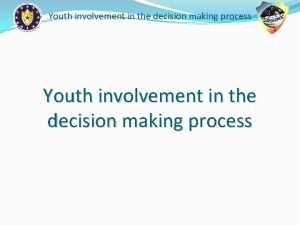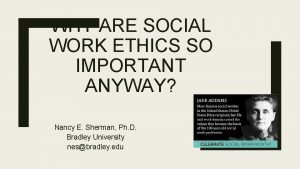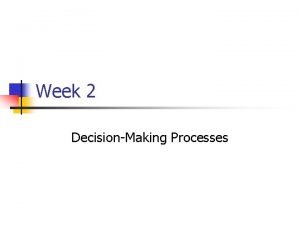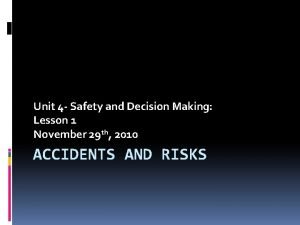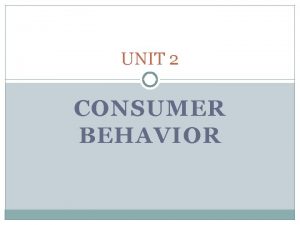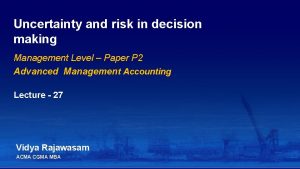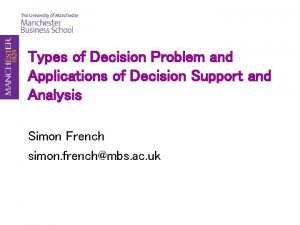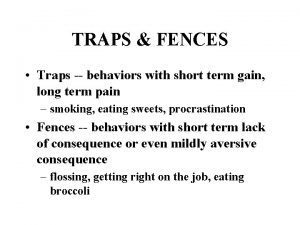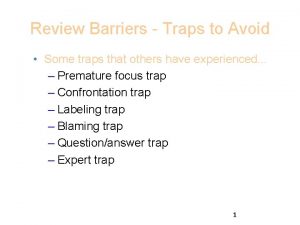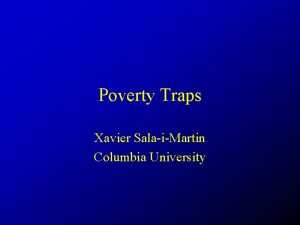Decision Making Traps n n Traps in general
















- Slides: 16

Decision Making Traps n n Traps in general Implications for Heuristic methods, forecasting, modeling in general.

1. Anchoring trap n first impressions n n Time series forecasting? Credit risk model n n too many inquiries get negative weight (how many is too many? )

2. Status Quo Trap n That’s the way it has always been n n Inertia School bullying Key - doing something wrong is punished doing nothing is generally not punished

3. Sunk Cost trap n Digging the hole deeper n n n being blind to past mistakes corporate strategy -barriers to exit emotional attachment

4. Confirming Evidence Trap n n I have made up my mind, don’t confuse me with facts. Eg. Political candidate – who is more honest/worthy/qualified – Bush or Gore?

5. Framing Trap n Glass half full or half empty? n Biases in surveys

Problem n There are 600 people in a town that have been infected by a certain virus. There are two competing programs, of which one has to be selected. n n n If Program A is adopted, 200 people will be saved If Program B is adopted, there is a one-third probability that 600 people will be saved and a two -thirds probability that no people will be saved Which of the two programs would you favor?

Problem n There are 600 people in a town that have been infected by a certain virus. There are two competing programs, of which one has to be selected. n If Program C is adopted, 400 people will die n If Program D is adopted, there is a one-third probability that nobody will die and a two-thirds probability that 600 people will die n Which of the two programs would you favor?

Framing Effects n n The two sets of choices are objectively identical. Changing the description of outcomes from lives saved to lives lost is sufficient to shift prototypic choice from riskaverse to risk-seeking behavior.

6. Estimation traps n Decision calibration n n Overconfidence - if I am incompetent, I am probably ignorant of it. Lack of feedback - students may think they understand but fail on a test. Lack of confidence - learned helplessness? Recallability -what’s in the news?

Overconfidence Bias n n "People generally ascribe more credibility to data than is warranted and hence overestimate the probability of success merely due to the presence of an abundance of data" (Sage, 1981, p. 648). Predictive accuracy reaches a ceiling at an early point in an information gathering process Confidence in decisions continues to climb as more and more information is obtained This bias is most extreme in tasks of great difficulty

List of Names Instructions n n n Read the list once. n n n Margaret Thatcher James Eynon Barbara Walters Charles Stubbart Hillary Clinton Arlyn Melcher Indira Gandhi Jack Smith Madonna Greg White

Recall Test! n n Are there more men or women on the list? How many men are on the list? How many women are on the list? How confident are you of your answers? Provide a probability number ranging from 0 to 1 for each answer.

Recallability n n Situations in which people assess the frequency of a class or the probability of an event by the ease with which instances or occurrences can be brought to mind. People inadvertently assume that readilyavailable instances, examples or images represent unbiased estimates of statistical probabilities.

7. Representativeness n All families of six children in a city were surveyed. In 72 families the exact order of birth of boys and girls was G B B G. n What is your estimate of the number of families surveyed in which the exact order of births was B G B B?

Representativeness Bias n n n People consistently judge the more representative event to be more likely, whether it is or not. Leads to major errors in the estimation of subjective probabilities Subjective probability denotes any estimate of the probability of an event, which is given by subjects, or inferred from their behavior.
 Objectives of decision making
Objectives of decision making Investment decision financing decision dividend decision
Investment decision financing decision dividend decision Decision tree and decision table examples
Decision tree and decision table examples Involvement decision making
Involvement decision making Ethical assessment screen
Ethical assessment screen Systematic decision making process
Systematic decision making process Paced decision making
Paced decision making Mamdm
Mamdm Using recursion in models and decision making sheet 3
Using recursion in models and decision making sheet 3 Defining moments
Defining moments Unit 4 lesson 1 decision making
Unit 4 lesson 1 decision making Decision making to improve marketing performance
Decision making to improve marketing performance Types of decision making
Types of decision making Internal business management
Internal business management Decision making unit example
Decision making unit example Unstructured decision making
Unstructured decision making Predictive function of marketing research
Predictive function of marketing research



